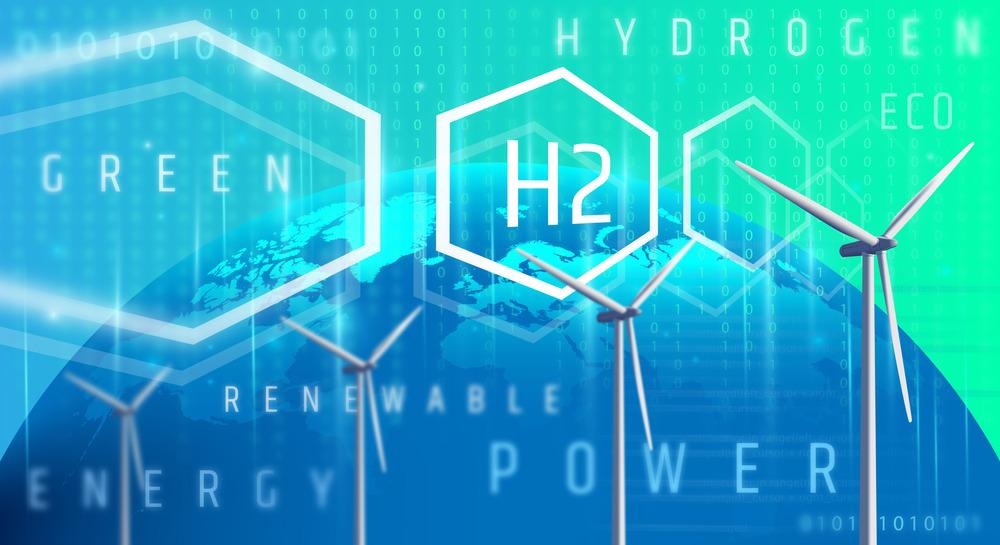
Hydrogen (H) is the lightest element, placed in the first group in the first period of the periodic table. Like carbon (C), hydrogen reacts with oxygen (O2) when it burns and releases energy. This reaction emits water vapor (H2O) into the atmosphere instead of carbon dioxide (CO2). In atmospheric air, a small quantity of nitrogen oxides are also in the vapor with the water molecules.
Importantly, the combustion reaction produces energy comparable to burning fossil fuels. This enables hydrogen’s applications as a fuel source. It is used in fuel cells – such as batteries – or in internal combustion engines. It can also be added to gas-based fuels for heating or cooking, for example, to reduce the amount of carbon dioxide they release when burned.
Like electricity, hydrogen is considered an energy carrier as it has to be generated from a primary source. Its pure form, H2, is rarely found in nature. To produce it, manufacturers need to extract H2 from water (H2O) or natural gas (methane, CH4).
The extraction process requires large amounts of energy, and not all of the energy input to the process is returned as usable hydrogen fuel. In other words, hydrogen production can be a relatively inefficient way of converting energy from a primary source into a usable energy carrier.
There is another problem with hydrogen’s environmental impact: steam methane reforming (SMR) represents 90% of all hydrogen production, and it requires the extraction and burning of natural gas and subsequent emissions of carbon dioxide into the atmosphere.
There are a few different methods for producing hydrogen that either reduces or eliminates these disadvantages. These methods are referred to with colors:
• Gray hydrogen is made with SMR using methane emissions that are by-products of other industrial processes
• Pink hydrogen is made with water electrolysis instead of methane, and energy is derived from nuclear power
• Blue hydrogen is made with SMR, but carbon dioxide emissions are captured and stored with appropriate carbon capture and sequestration (CCS) technology
• Green hydrogen is made with water electrolysis, and energy derived from renewable sources such as solar and wind.
IEA Calls for Investment in Low-Carbon Blue and Green Hydrogen
The International Energy Agency (IEA) recently reported that investment is needed to produce approximately 306 million tons of green hydrogen every year by 2050 in order to meet net-zero emissions targets.
In the same report, the IEA also called for more investment in blue carbon to bring production capacity up to 197.6 million tons per year by 2050.
The organization added that 16 million tons of pink carbon will be needed as well.
This is a total of 520 million tons of low carbon hydrogen fuel to be used across the world economy, expanding industrial applications for hydrogen far beyond today’s relatively limited use cases. Currently, most hydrogen is produced for the chemical manufacturing and oil refinery industries.
To get to 520 million tons of annual low carbon hydrogen output, the IEA reported that the sector will need to grow at a CAGR of 66% in the 2020s, and then at 23% between 2030 and 2050.
Is Blue Hydrogen Really Low Carbon?
The most common method for producing hydrogen is SMR.
Blue hydrogen (which captures carbon dioxide emissions at the source with CCS technology) and gray hydrogen currently account for about 95% of all hydrogen in production today.
SMR uses a reaction between natural gas and steam at extremely high temperatures to make carbon monoxide and hydrogen. The water-gas shift (WGS) reaction creates more steam to react with carbon monoxide to produce more hydrogen, and carbon dioxide molecules.
Blue hydrogen tackles this problem with CCS technology, however, it still requires the extraction and use of natural gas.
Many researchers are beginning to identify fugitive methane emissions as an important yet overlooked part of the global warming problem. These are emissions caused by natural gas leaking at various points in its infrastructure from extraction to use.
When fugitive methane is factored into the equation, blue hydrogen performs worse than some fossil fuels in terms of greenhouse gas emissions. Researchers have found that blue hydrogen releases 20% more greenhouse gases than natural gas or coal when burned for heat, and 60% more than burning diesel oil for heat.
Is Green Hydrogen Practical?
Green hydrogen – produced using water electrolysis and energy from renewable sources – can still be a carbon-free energy carrier. However, it requires significant investment to establish and, with the current state-of-the-art technology, maintain green hydrogen production facilities.
Electrolysis is a more expensive and complicated process than SMR, and even with the best electrolysis methods available, only about 70-80% of the energy input is converted into usable hydrogen fuel.
Green hydrogen production also requires investment in on-site renewable energy generation and has to take place somewhere with ample and reliable renewable energy sources.
As a result of these costs, green hydrogen still makes up only a small fraction of the world’s hydrogen output – 8 GW or 4%. For hydrogen to achieve its carbon-free energy potential, significant investment is needed.